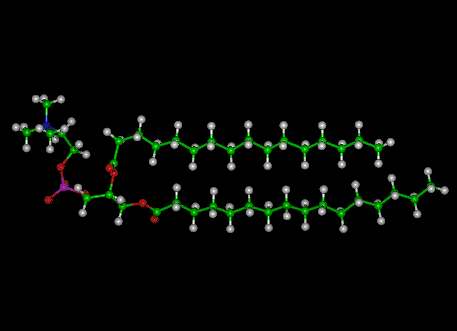Phosphatidylcholine Acid Molecule (DPPC)

Phosphatidylcholine Molecule Ball-and-Stick Model
To View the Phosphatidylcholine Molecule in 3D --->>in 3D with Jsmol
Phosphatidylcholine is a phospholipid that is a major constituent of cell membranes. Phospholipids consist of a water-soluble head (a positively charged (polar) group), linked to two water-insoluble nonpolar tails (by a negatively charged phosphate group). Both tails consist of a fatty acid, each 14-24 carbon groups long.
Common types of phospholipids are: phosphatidylethanolamine (PE), phosphatidylinositol (PI), phosphatidic acid (PA) and phosphatidylcholine (PC) Phospholipids are also present in lecithin. Approximate level of phospholipids in lecithin is 50%.
Due to its polar nature, the head of a phospholipid is attracted to water (it is hydrophilic). The nonpolar head is not attracted to water and is said to be hydrophobic. When placed in water, phospholipids form a bilayer, where the hydrophobic tails line up against each other. This forms a membrane with hydrophilic heads on both sides. This membrane is partially permeable and very flexible.
Phosphatidylcholine is important for normal cellular membrane composition and repair. Phosphatidylcholine is also the major delivery form of the essential nutrient choline. Choline itself is a precursor in the synthesis of the neurotransmitter acetylcholine. Phosphatidylcholine is also involved in the hepatic export of very-low-density lipoproteins.
Phosphatidylcholine may be indicated to help restore liver function in a number of disorders, such as alcoholic fibrosis, and possibly viral hepatitis. It may also be indicated for the treatment of some manic conditions. There is some evidence that Phosphatidylcholine may be useful in the management of Alzheimer's disease and some other cognitive disorders.